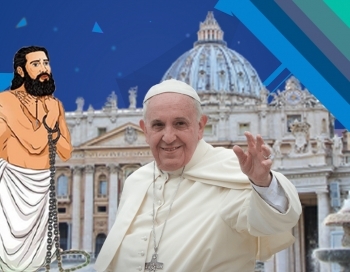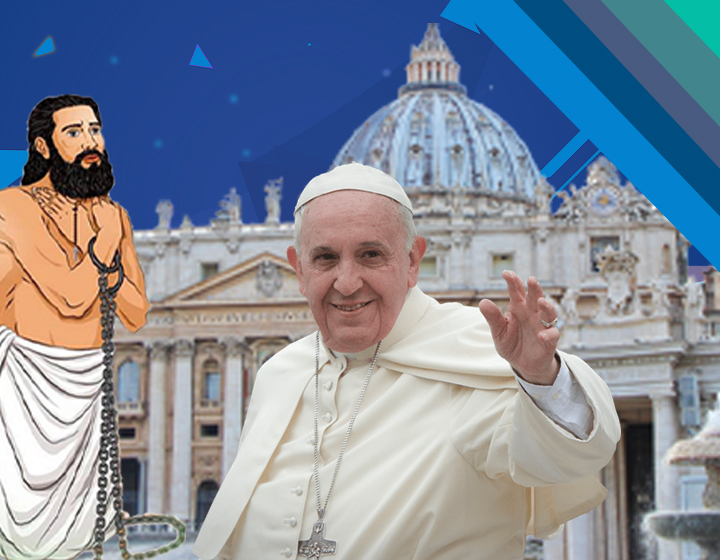
 John Kulandai
John Kulandai

The Church in India has now the glory of a new saint, martyr Devasahayam, canonized by Pope Francis on 15 May, 2022 at St. Peter’s Square, Vatican. I have been privileged to have been connected with the Cause from the beginning. Now filled with the joy of having realised the dream of two-and-a-half centuries, I would like to elaborate on the saint together with information on different steps taken to reach the canonization.
Sources
One of the allegations against the Cause of the martyr is that there is not sufficient historical sources. On the contrary, there is an uninterrupted flow of documents/books from 1751, one year before the heroic death of Devasahayam to the present year 2022.
Secondly, the variety of the nature of sources makes one marvel at the impact this one person has made on writers, poets, dramatists, and even artists. There are manuscripts, books, dramas, and poems on our hero. We can certainly say very few personalities in India, with the exception of persons like Mahatma Gandhi, may have had such a long standing influence in the consciousness of people as Devasahayam had.
Thirdly, the extensive spreading of the story of life and passions of the martyr baffles us. Even a quick glance through the bibliography will make anyone wonder how a 40-year-old palace official in the kingdom of Travancore, who lived and died in the southern-most part of Indian subcontinent, had positively affected the consciousness of people not only through the length and breadth of Tamil Nadu but also Sri Lanka, Kerala and even Europe. Any reader can observe that the sources come from almost the entire world and the archives and libraries are spread throughout three continents: Asia, Europe and America.
Fourthly, one can speak of a certain linguistic globality with regard to the original language of the sources. There is a large variety in it. The sources are in Latin, English, Italian, French, Portuguese, Dutch, Tamil and Malayalam. Our archives are equipped with full details on these sources and the following informations are gathered from them, and not just from oral tradition or mythological imagination.
Life and Martydom
Devasahayam was born on 23 April, 1712 in the hamlet called Nattalam of the former kingdom of Travancore and the Killiyoor Taluk in the present district of Kanyakumari, Tamil Nadu. His father, Vasudevan Namputhiri, a Brahmin, was an emigrant from Maruthangkulakkara near Kayamkulam of the same kingdom and at present part of Kollam district in Kerala. His mother Devahi Amma was the daughter of Raman Pillai of Nattalam, of the Nair Caste. The original name of the martyr was Nilam, also expanded as Nilakandan. Because of the tradition of marumakkathayam, which followed a matrilineal lineage of inheritance by identifying the caste of the children by the caste of the mother, Nilam too was considered to be of the Nair caste, which was considered a high caste, next only to the topmost Brahmin caste.
An Offcial Loved by All
Nilam was brought up as a devout Hindu. Besides Tamil and Malayalam, the languages of people, he also trained himself in archery, Varmasastra and the use of weapons of war. Nilakandan started his career as a soldier. Later on, he was an official in the Nilakandaswamy temple at Padmanabhapuram. He was a palace official, working in the king’s treasury. This job later brought him to Udayagiri fort as the paymaster to the construction labourers of the fort. In the age of 27, Nilakandan married Bhargaviammal of the village of Mekkodu and was leading a happy married life.
His Evangelization
In performing his duties as a palace official, Nilam came in contact with a Catholic officer, Eustachius Benedictus De Lannoy, a Dutch military officer, who together with 23 others, had surrendered to the king Marthanda Varma during the war at the Port of Colachel in 1741, which the king won.
During this period, Nilakandan was found to be extremely sad. When De Lannoy enquired about the reasons for his sadness, Nilam narrated a series of tragedies that had overtaken his family. On hearing that, De Lannoy narrated to him the Old Testament story of Job and demonstrated how God allowed a good man to be tested through sufferings and losses. Finding De Lannoy's explanation reasonable and convincing, Nilakanda Pillai expressed his desire to become a Christian. De Lannoy sent him to Fr. Giovanni Baptista Buttari, a Jesuit Missionary, of the Namon Mission, a resident of Vadakkankulam outside the limits of the kingdom of Travancore.
Fr. Buttari instructed Nilam in the Catholic faith for nine months. Finally, Fr. Buttari baptized him at the church of the Holy Family, Vadakkankulam on 14 May, 1745. At the baptism, he was given the name "Devasahayam" which is a Tamil rendering of the Biblical name Lazarus, which means "God has helped".
Lay Man and Missionary
Having joined the Catholic community, Devasahayam himself started evangelizing others and brought some to Christian faith, one of them being his own wife who took the name "Gnanapu" which is a Tamil rendering of "Theresa". Devasahayam mingled with people of all statuses and castes. Because of his newly-found faith, he disregarded caste distinction, threw away the symbols of his "high" caste, ate and lived with people of "low" birth. Noticing the marked changes in Devasahayam because of his Christian life, the high caste people accused him of insult of gods (deiva throgam), insult of Brahmins and violation of the Caste system (kula throgam) and the royal throne (raja throgam).
A Witness to Catholic Faith
Some persons of high caste and court officials tried to woo the martyr back from his newly won Christian faith. But he showed great fortitude in expressing firmness of faith and even daringly declared that he was willing to be tortured or even put to death for Christ.
The king, having been incited against Christians, arrested Devasahayam on 23 February, 1749 and put him in a very narrow prison. Soon condemned to death by the king, the martyr was tortured in several ways. He was paraded to many towns and villages, both hands bound by chains, seated on a buffalo, garlanded with Erukku flowers as a symbol of shame. Finally, the he was taken to the prison at Aralvaimozhi, on the border between the kingdoms of Madurai (Pandiya Kingdom) and Travancore.
During the years of his arrest and torture, the martyr led a life worthy of a candidate for martyrdom. Every morning and night he spent certain time in personal prayer. He fasted on all Fridays and Saturdays in honour of the death of Christ and of the sorrows of the blessed Virgin Mary. Whenever a priest visited him, he confessed his sins and received holy Eucharist with utmost devotion. He always exuded deep joy and love and respect to everyone.
A Witness by Blood
A lot of people continued to visit Devasahayam in the prison. Therefore, it was planned to eliminate him secretly. So, a little before the midnight of January 14, 1752 he was litterally carried to the place. There he knelt and prayed for a while intensely. Then he was shot dead by the soldiers with five leaden bullets, at midnight between 14 and 15 January, 1752.
His body was thrown in between rocks and left there to be eaten by wild animals. His mortal remains were discovered by the Christians and buried in front of the main altar in the most important church of St. Francis Xavier, which is the present Cathedral of the Diocese of Kottar.
From the day of his death to this very day, martyr Devasahayam continues in the consciousness of the people of the region and even the entire South India. The story of his death is being narrated year after year in dramas, poems and folklore throughout the Tamil speaking world, including Jaffna in Sri Lanka.
The places connected to his life and death became important places of pilgrimage by all people. In his memory, churches were constructed at Kattradimalai (Our Lady of Sorrows) and Puliyoorkurichy (St. Michael) and Kuzhimaikadu (St. Antony). Nattalam (the place of his birth), Kattadimalai (the place of his martyrdom) and Puliyoorkurichy (the place where water flowed from the rock when Devasahayam hit with his elbow) have turned out to be important shrines in the district and people from all over Tamil Nadu and from south Kerala frequent them in great numbers.
Devasahayam is one of the popular names for Catholics or non-Catholic Christians in Tamil Nadu.
Declaration of beatification
Though a lot of enthusiastic attempts were made from the year 1986 (Pope John Paul II’s visit and the beatification of Alphonsa), the proper application to Rome was made on 25 October, 2003. The first stage of Canonization was declaration of martyrdom, which is same as beatification; it had Fr. George Nudungatt SJ as Postulator and it lasted only nine years. The altogether quick process had a happy conclusion on December 2, 2012.
The Process of Canonization
The process of Canonization had a definite direction in 2014, when the Bishop of Kottar got information about an extraordinary event reportedly wrought by the intercession of the Blessed Martyr Devasahayam in 2013. It was the revitalization of a 28-week fetus, certified and declared as an “intra uterine fetal death”. The lifeless fetus was in the “traverse lie” position at the time of the scan. On the receipt of the report, the utterly shocked mother started praying to the Martyr, drinking the water from the well of the house of Devasahayam at Nattalam. After an hour, the mother felt that she was feeling better. Upon immediate check-up by the medical team, it was confirmed that the fetus’ heartbeat was detected again and the mother’s condition was returning to normal. The mother, after three months, delivered a healthy male baby by a normal delivery and the child was baptized as “Devin Joe”.
The diocesan enquiry established by the then Bishop Peter Remigius and the subsequent Roman process, with the involvement of physicians and medical, canonical and theological experts resulted in the Papal approval of miracle and clearing the name for Canonization on February 21, 2020. the declaration was that “the unexpected revival of the heartbeat of the fetus in the 28th week of conception, with successive progress towards a normal completion of childbirth without any negative consequence either to the fetus or to the mother” is a miracle wrought by God through the intercession of Blessed Martyr Lazurus i.e. Devasahayam.”
There was a Consistory of Cardinals on Canonization on May 3, 2021; on November 9 Rome came out with another announcement: Canonization is to take place in the Basilica of St. Peter, Rome on May 15, 2022.
What is special about martyr St. Devasahayam? He is not just another one on the list of Catholic saints. There is something special about him.
Many firsts
He is the first Indian, born on Indian soil, declared as a martyr for shedding his blood for Christ on Indian soil and the first married lay person in India to be included in the list of saints and the first saint from the State of Tamil Nadu.
A saint for our times
a. In this time of religious fanaticism soring to the level of suppression of religious freedom, the martyrdom of Devasahayam calls for commitment to religous tolerance and religous integration.
b. When there are so many threats to the ministry of evangelization, the new saint shows us the path to fortitude and courage, marked by dialogue of love and coordinated action for the good of all.
c. In this era of caste-ridden politics in the society, state and even in the Church, Devasahayam shines out as a saint for social equality, calling us all to build a society devoid of caste and class hierarchy.